Top Rankings
Woodland Hills School District ranks among the top 20% of public school district in Pennsylvania for:
Category
Attribute
Diversity
Most diverse schools (Top 1%)
For the 2025 school year, there is 1 public high school serving 966 students in Woodland Hills School District. This district's average high testing ranking is 3/10, which is in the bottom 50% of public high schools in Pennsylvania.
Public High School in Woodland Hills School District have an average math proficiency score of 37% (versus the Pennsylvania public high school average of 40%), and reading proficiency score of 42% (versus the 58% statewide average).
Public High School in Woodland Hills School District have a Graduation Rate of 81%, which is less than the Pennsylvania average of 88%.
The school with highest graduation rate is Woodland Hills High School, with 81% graduation rate. Read more about public school graduation rate statistics in Pennsylvania or national school graduation rate statistics.
Minority enrollment is 73% of the student body (majority Black), which is more than the Pennsylvania public high school average of 39% (majority Black and Hispanic).
Overview
This School District
This State (PA)
# Schools
5 Schools
790 Schools
# Students
3,080 Students
641,839 Students
# Teachers
244 Teachers
46,794 Teachers
Student : Teacher Ratio
13:1
13:1
District Rank
Woodland Hills School District, which is ranked within the bottom 50% of all 675 school districts in Pennsylvania (based off of combined math and reading proficiency testing data) for the 2021-2022 school year.
The school district's graduation rate of 78% has decreased from 89% over five school years.
Overall District Rank
#551 out of 684 school districts
(Bottom 50%)
(Bottom 50%)
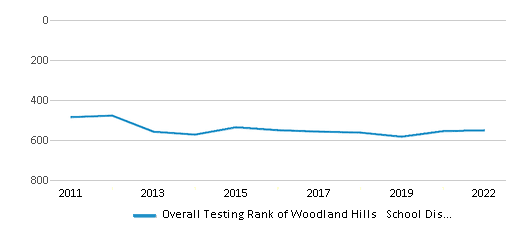
Math Test Scores (% Proficient)
17%
36%
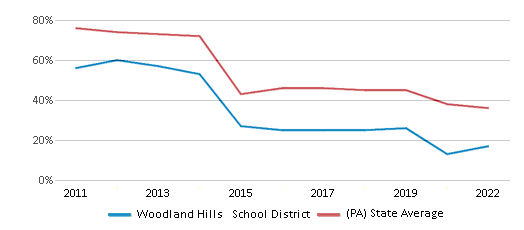
Reading/Language Arts Test Scores (% Proficient)
31%
55%
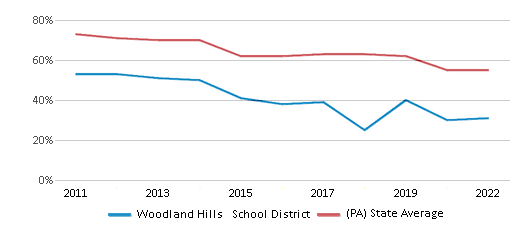
Science Test Scores (% Proficient)
37%
57%
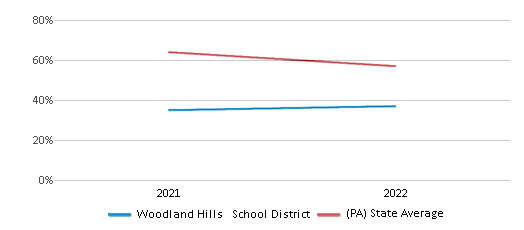
Graduation Rate
78%
87%
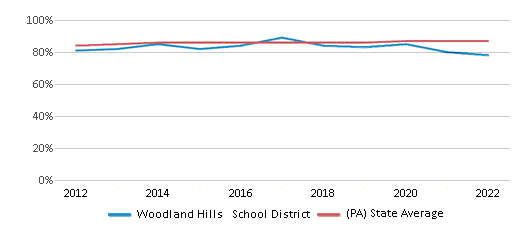
Students by Ethnicity:
Diversity Score
0.56
0.59
# American Indian Students
7 Students
1,234 Students
% American Indian Students
n/a
n/a
# Asian Students
20 Students
27,995 Students
% Asian Students
1%
4%
# Hispanic Students
168 Students
95,297 Students
% Hispanic Students
6%
15%
# Black Students
1,889 Students
97,149 Students
% Black Students
61%
15%
# White Students
722 Students
389,936 Students
% White Students
23%
61%
# Hawaiian Students
n/a
668 Students
% Hawaiian Students
n/a
n/a
# Two or more races Students
274 Students
30,280 Students
% of Two or more races Students
9%
5%
Students by Grade:
# Students in PK Grade:
70
113
# Students in K Grade:
269
4,922
# Students in 1st Grade:
242
5,545
# Students in 2nd Grade:
248
5,826
# Students in 3rd Grade:
211
5,948
# Students in 4th Grade:
239
6,285
# Students in 5th Grade:
219
7,067
# Students in 6th Grade:
209
10,202
# Students in 7th Grade:
158
26,101
# Students in 8th Grade:
249
28,685
# Students in 9th Grade:
288
141,278
# Students in 10th Grade:
281
138,350
# Students in 11th Grade:
212
131,935
# Students in 12th Grade:
185
129,582
# Ungraded Students:
-
-
District Revenue and Spending
The revenue/student of $33,025 is higher than the state median of $23,696. The school district revenue/student has stayed relatively flat over four school years.
The school district's spending/student of $39,836 is higher than the state median of $23,119. The school district spending/student has stayed relatively flat over four school years.
Total Revenue
$102 MM
$39,541 MM
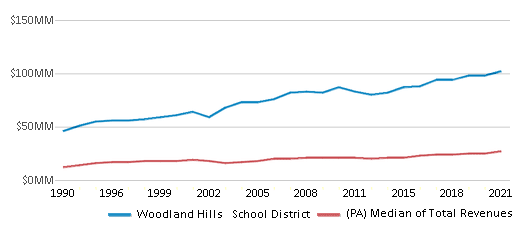
Spending
$123 MM
$38,578 MM
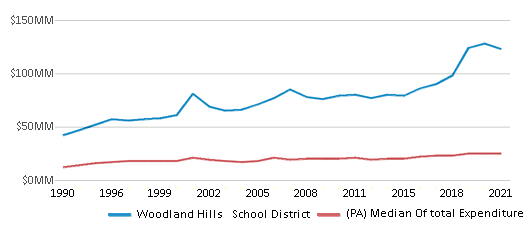
Revenue / Student
$33,025
$23,696
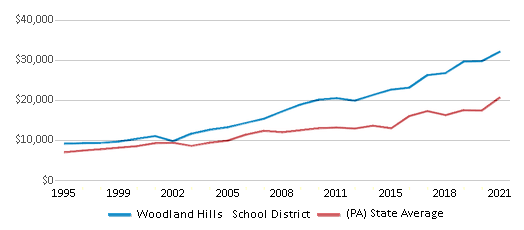
Spending / Student
$39,836
$23,119
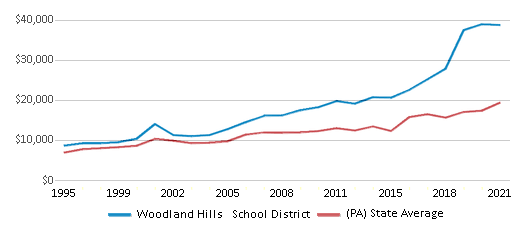
Best Woodland Hills School District Public High Schools (2025)
School
(Math and Reading Proficiency)
(Math and Reading Proficiency)
Location
Grades
Students
Rank: #11.
Woodland Hills High School
(Math: 35-39% | Reading: 40-44%)
Rank:
Rank:
4/
Bottom 50%10
2550 Greensburg Pike
Pittsburgh, PA 15221
(412) 244-1100
Pittsburgh, PA 15221
(412) 244-1100
Grades: 9-12
| 966 students
Recent Articles

Year-Round Or Traditional Schedule?
Which is more appropriate for your child? A year-round attendance schedule or traditional schedule? We look at the pros and cons.

Why You Should Encourage Your Child to Join a Sports Team
Participating in team sports has a great many benefits for children, there is no doubt. In this article you will learn what those benefits are.

White Students are Now the Minority in U.S. Public Schools
Increasing birth rates among immigrant families from Asia and Central and South America, combined with lower birth rates among white families, means that for the first time in history, public school students in the United States are majority-minority. This shift in demographics poses difficulties for schools as they work to accommodate children of varying language abilities and socio-economic backgrounds.





